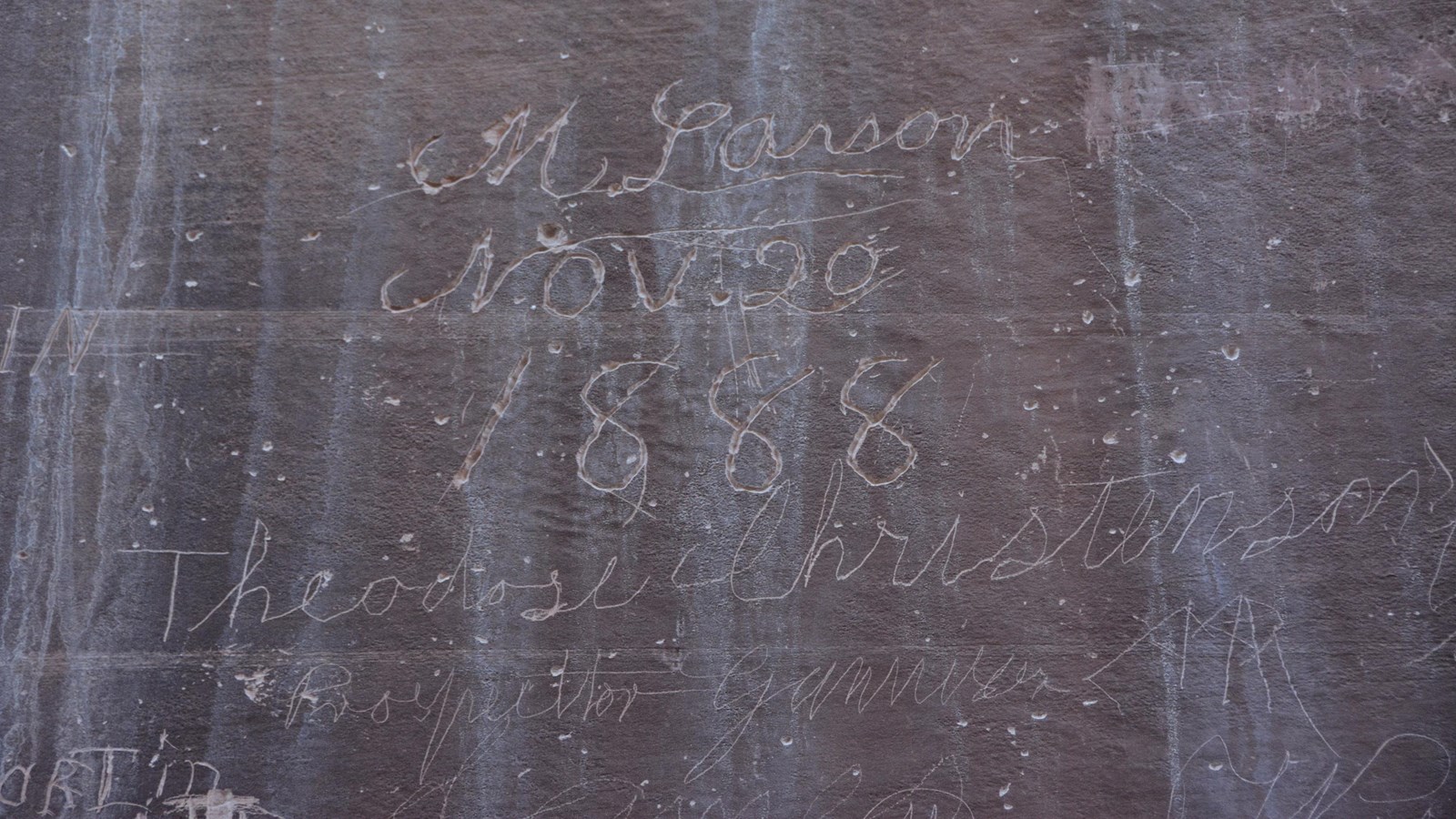Last updated: March 12, 2025
Place
Pioneer Register

NPS/ C. Roundtree
Scenic View/Photo Spot
At the end of the Scenic Drive, take an easy stroll down Capitol Gorge, and about half a mile (0.8 km) from the trailhead, look at the north side of the canyon wall (left). Notice the many names, dates, and places carved, painted, and in one case, shot, into the sandstone. Prospectors, explorers, surveyors, cowboys, area settlers, and early visitors would often stand on their wagons to carve their names into the canyon wall. They were leaving their mark above flash flood danger, likely hoping their names would survive for centuries.
These inscriptions provide an important log of those who passed through the region, and they offer insight into the men and women who left their names behind. The earliest inscriptions belong to two mineral prospectors, J.A. Call and Wal. Bateman. These men were probably in search of economic wealth from mining and travelled through Capitol Gorge September 20, 1871. Aside from their names, the date, and “PROSSPECTER,” very little is known about these two men. If they hadn’t left their mark, no one would know they were likely the earliest Euro-American presence in the Capitol Reef region. They were not part of a large, government-sponsored expedition, like the 1872 trip through Capitol Reef lead by Almon Thompson, under the larger J.W. Powell Expedition. It is now illegal to carve, paint, scratch, or otherwise deface any canyon wall, historic, or archeological site.
The names of many early Fruita and Wayne County residents can be found on the register: E.P. Pectol, Aaron Holt, Walter and E.J. Hanks as well as members of the Oyler, Smith, Carrell, and Cook families.
Other notable local people include Hanksville shop owner C.A. Gibbons who supposedly furnished Zane Gray with the story of Wildfire, his 1915 novel. A group of French archeologists looking at ruins in the area also left their names behind: G. Guiraud, A. Pillaud, P. Brossard, and T. Breard on January 30, 1893.
As you return to the parking lot, look for four inscriptions towards the top of the cliff, on the south side of the canyon walls. These names belong to surveyors. One of their descendants, Pam Stewart, provides the story behind them. Her great-uncle, John R. Stewart, and his half-brother Quinby, worked for the state of Utah as land surveyors in 1912. They had contracted a crew of University of Utah geology students to help them over the summer.
According to Pam and her family, “It is said that Quinby got the idea of fooling the new bunch, commenting on the speed of erosion in the Reef. One evening, leaning on the buck board, he said to his youthful and unexperienced crew, "My how it erodes down here." After a pause he consulted John R., "Isn't this the place we were at this time last year?" Later, after dark, when the rest of the camp were asleep, Quinby and John R. took some ropes, hammers, and chisels and snuck off down the draw to where canyon wall was a sheer rock face about 50 feet high. There, they climbed to the top where Quinby was lowered over the edge and down the face. There he dangled in a rope chair, while he chiseled their names and last year's date in good engineering letters two feet high on the rock face.
The next day as they were working in the canyon, Quinby remarked, "I think we were standing about here when we carved our names in some rock face..." He then pointed out the names and date to his hapless audience, with the comment that he had stood on the bed of a wagon to do the inscribing. This would have required about 40 feet of erosion in one year.
The tale stops there, leaving it to the reader to imagine the amazement of the University crew, and the ensuing confusion when they confidently informed their professors of the rapid erosion in the southern deserts. One can only hope that some kind mentor set them straight before the joke went too far.”
As you continue to explore, help protect Capitol Reef National Park by not leaving your mark. Make memories, take photos & leave no trace.The Archaeological Resources Protection Act of 1979 (ARPA) states that all acts of vandalism are illegal and are punishable by up to 2 years in prison and/or a $20,000 fine. Help spread the word and let others know that these activities are illegal.
Anyone with information concerning vandalism within Capitol Reef National Park should immediately contact the National Park Service. Report all crimes or suspicious activity to the Visitor Center or a National Park Service employee, or call the Capitol Reef tip line at (435) 425-4134.
Find the Pioneer Register and Capitol Gorge on the Fruita Map and Guide.
